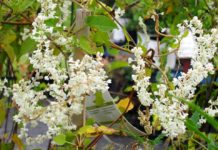Jasmines may twine to some extent, but as a group, they’re really in the category of shrubs. Some have long, arching stems, and are therefore grown as vines. These plants are popular in warm climates, where they’re usually evergreen and bear lovely flowers in spring or summer, sometimes even in winter; many are extremely fragrant. Common jasmine (Jasminum Officinale) is vigorous and hardy in Zone 7. It will grow to 30 feet; fragrant white flowers appear in the summer. Winter jasmine (J. nudiflorum) grows much less tall and is hardy in Zone 6.
Yellow flowers, which are not fragrant, appear before the leaves in early spring in cooler climates, and in winter in warm ones. Pink jasmine (J. polyanthum), whose flowers are more white than pink, has small, dainty leaves and starts blooming in winter in warm climates. It is hardy only in Zones 8 to 9, but can be grown successfully indoors and is very fragrant. Many jasmines make good container plants, indoors or out. Some of the larger ones make good, dense, fragrant hedges.
There are many other jasmines worth exploring, especially if you live in a warm climate. The plant called “star jasmine” (Trachelospermum jasminoides) is actually not jasmine. It is an evergreen bears fragrant white flowers in spring and summer and is a good screening plant in frost-free regions.
How to Grow Jasmine?
Jasmines prefer sun, though some may do well in part shade. Any well-drained, light loam is suitable as long as it has some moisture. Most need pruning to keep them within bounds. With indoor plants, especially, it is important to cut them back hard after blooming to encourage branching and more bloom. The stems must be anchored to their supports. Propagate from cuttings or by layering.








